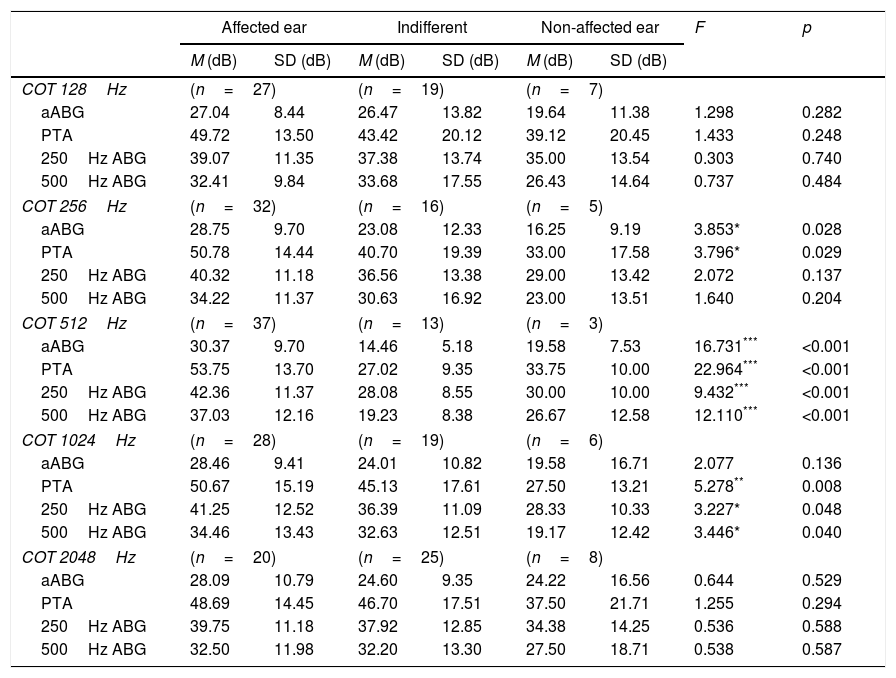The contralateral occlusion test (COT) has the potential to allow the quantitative evaluation of unilateral conductive hearing loss. The purpose of this study was to determine the accuracy of the test in predicting the degree of hearing loss.
Materials and methodsFifty-three subjects with unilateral conductive hearing loss were recruited from an otolaryngology department of a tertiary hospital. The COT was performed using 128, 256, 512, 1024 and 2048Hz tuning forks with the non-affected ear canal totally occluded to determine lateralization. Pure-tone audiometry was performed to establish the presence and degree of the air-bone gap (ABG) and the pure-tone average (PTA). The tuning fork responses were correlated with the ABG and the PTA to determine their accuracy.
ResultsThe COT showed a better association between hearing loss and the lateralization response using the 512Hz tuning fork (p=0.001). The sensitivity of the 512Hz fork in detecting a PTA of at least 35.6dB was 94.6% and the specificity was 75.0% for a positive predictive value of 89.7% and a negative predictive value of 85.7%, assuming a pretest prevalence of 69.8%.
ConclusionsThe overall accuracy of the COT in predicting the degree of unilateral conductive hearing loss was significant. The COT had significant power in one direction: if lateralization to the affected ear occurred, it was almost certain evidence of a moderate or severe conductive hearing loss.
La prueba de oclusión contralateral (POC) nos permite realizar una evaluación cuantitativa de la hipoacusia transmisiva unilateral. El objetivo de este estudio consistió en determinar la exactitud de esta prueba para predecir el grado de pérdida auditiva.
Material y métodosFueron reclutados 53 pacientes con hipoacusia unilateral transmisiva en el departamento de otorrinolaringología de un hospital terciario. La POC fue realizada utilizando diapasones de 128, 256, 512, 1024 y 2048Hz, con el conducto auditivo del oído sano totalmente ocluido, para determinar la lateralización. Se realizó una audiometría de tonos puros para establecer la presencia y grado del umbral diferencial de audición (UDA) y del Promedio de Tonos Puros (PTA). La respuesta con los diapasones fue correlacionada con el UDA y la PTA para determinar su exactitud.
ResultadosLa POC demostró una mejor asociación entre la pérdida auditiva y la lateralización, usando el diapasón de 512Hz (p=0,001). La sensibilidad del diapasón de 512Hz en detectar la PTA, de al menos 35,6dB, fue del 94,6% y la especificidad del 75%, y un valor predictivo positivo de 89,7% y valor predictivo negativo de 85,7%, asumiendo la prevalencia pre-test del 69,8%.
ConclusionesLa precisión general de la POC en predecir el grado de pérdida auditiva transmisiva unilateral fue significativa. La POC puede ser utilizada de forma significativa en los casos de lateralización al oído afecto, ya que existe una evidencia casi segura de una pérdida auditiva transmisiva moderada o severa.
Artículo
Comprando el artículo el PDF del mismo podrá ser descargado
Precio 19,34 €
Comprar ahora












